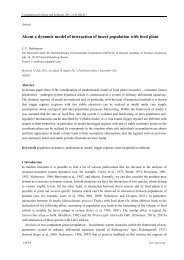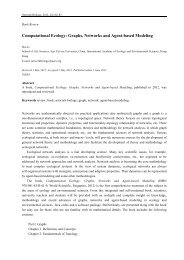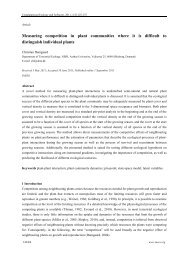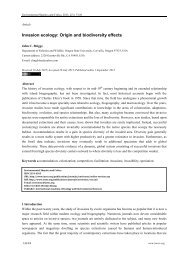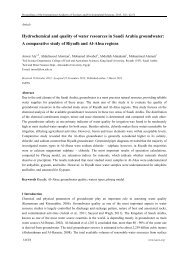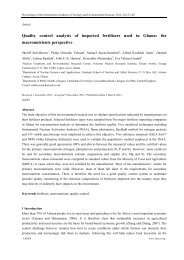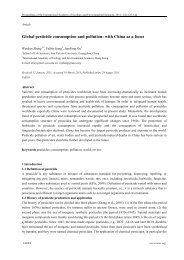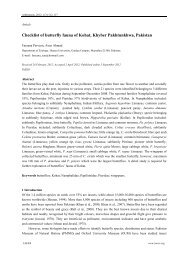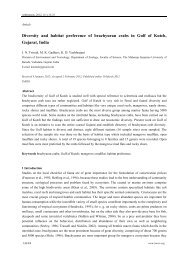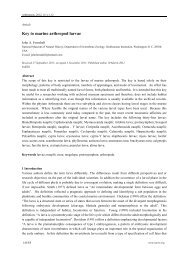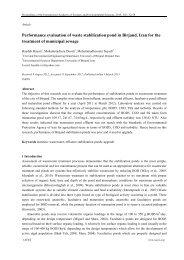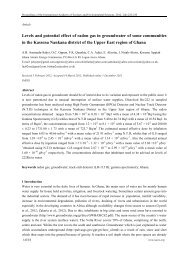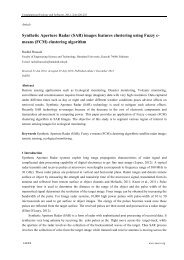SWOT analysis of Tandooreh National Park (NE Iran) for sustainable ...
SWOT analysis of Tandooreh National Park (NE Iran) for sustainable ...
SWOT analysis of Tandooreh National Park (NE Iran) for sustainable ...
You also want an ePaper? Increase the reach of your titles
YUMPU automatically turns print PDFs into web optimized ePapers that Google loves.
304<br />
Proceedings <strong>of</strong> the International Academy <strong>of</strong> Ecology and Environmental Sciences, 2013, 3(4): 296-305<br />
W-O strategies: The strategies which can be used to overcome weaknesses by pursuing opportunities are<br />
1. Increase research funding <strong>for</strong> scientific studies and research in the area to decrease negative impacts.<br />
2. Facilitating the tours operated by tour operators with collaboration <strong>of</strong> the authorities and local people.<br />
3. Establishment <strong>of</strong> well equipped wild life-watching site in different locations in the park.<br />
4. Attracting ecotourism throughout the year by holding ecotourism festivals in the areas which have<br />
different weather, climate and culture.<br />
5. Integration <strong>of</strong> solid waste management plan into environmental education and planning <strong>of</strong> solid waste<br />
rules and regulations <strong>for</strong> visitors.<br />
W-T strategies: To establish a defensive plan to prevent the park's weaknesses from making it highly<br />
susceptible to the external threats following strategies have been suggested.<br />
1. Infrastructure development harmonized with population increase caused by tourist visits<br />
2. Environmental education to the building contractors and tour operators in reducing the environmental<br />
impacts.<br />
3. Investing to improve the quality <strong>of</strong> infrastructures, such as road transport systems, hospitality and<br />
accommodation centers, medical and health services, increasing access to new technologies, such as Internet,<br />
telephone, post, guiding s<strong>of</strong>tware and so on in ecotourism regions<br />
4. Developing international collaborative activities to receive support in the field <strong>of</strong> research and<br />
development related to <strong>sustainable</strong> ecotourism.<br />
References<br />
Asadi R. 2012. Strategies <strong>for</strong> <strong>Iran</strong> ecotourism. World Applied Sciences Journal, 18 (3): 414-424<br />
Barzekar G, Aziz A, Mariapan M, et al. 2011. Delphi technique <strong>for</strong> generating criteria and indicators in<br />
monitoring ecotourism sustainability in Northern <strong>for</strong>ests <strong>of</strong> <strong>Iran</strong>: Case study on Dohezar and Sehezar<br />
Watersheds. Forestalia Polonica Series A, 53(2): 130-141<br />
Ceballos-Lascurain H. 1996. Tourism, Ecotourism and Protected Areas. IUCN. The World Conservation<br />
Union. Gland, Switzerland<br />
DOE. 2011. Protected areas in <strong>Iran</strong>. http://www.doe.ir/portal/Home/Default. aspx?CategoryID=194f31a0-<br />
4030-446f-8a8a-3b49774ba52d. Accessed Feb, 2011<br />
Ebrahimzade E, Aghasizade A. 2009. Analysis <strong>of</strong> factors affecting tourism in Chabahar coastal area by using<br />
the <strong>SWOT</strong> strategic. Urban Studies and Research and Regional, <strong>Iran</strong>, 1(1): 107-128<br />
Gilmour DA. 1995. Conservation and development: seeking the linkages. Community development and<br />
conservation <strong>of</strong> <strong>for</strong>est biodiversity through community <strong>for</strong>estry. Proceedings <strong>of</strong> an International Seminar,<br />
Bangkok, Thailand<br />
Harfst J, Wirth P, Lintz, G, Bieberstein,C. 2010. Strengths, Weaknesses, Opportunities and Threats <strong>of</strong><br />
European mining regions (<strong>SWOT</strong> Report I). Leibniz Institute <strong>of</strong> Ecological and Regional Development<br />
(IOER), Dresden, Germany<br />
IUCN. 2012. The IUCN Red List <strong>of</strong> Threatened Species. Version 2012.2. http://www.iucnredlist.org<br />
Jozi SA, Aghapour P, Khalilzadeh Poshtegal. M, et al. 2010. Presentation <strong>of</strong> strategic management plan in<br />
ecotourism development through <strong>SWOT</strong>: Case study <strong>of</strong> Qeshm Island. Journal <strong>of</strong> Food, Agriculture and<br />
Environment, 8(2): 1123-1132<br />
Martha H. 2008. Ecotourism and Sustainable Development: Who Owns Paradise? Island Press, USA<br />
Mokhtarshahi Sani R, Mahasti P. 2012. Regenerating regional identity <strong>for</strong> <strong>sustainable</strong> tourism development<br />
case study, Eslami Island, <strong>Iran</strong>. Procedia - Social and Behavioral Sciences, 35: 523-530<br />
IAEES<br />
www.iaees.org



